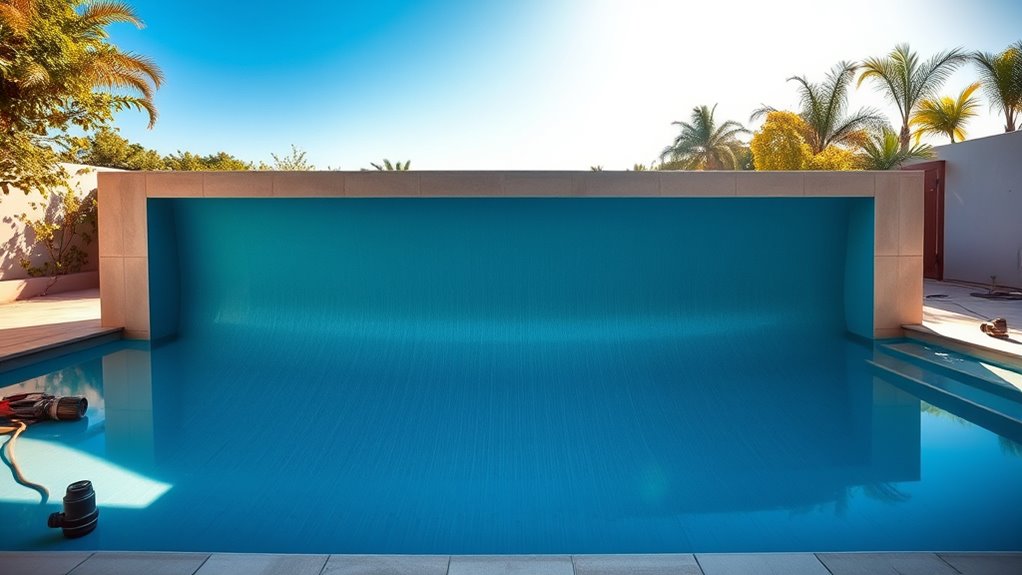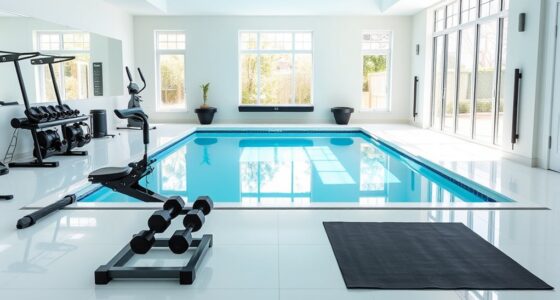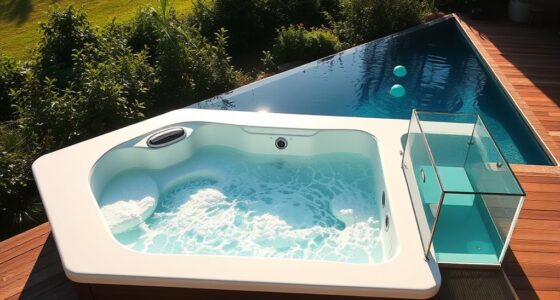To avoid costly mistakes when installing your DIY endless pool, choose an ideal location away from shade, trees, and utilities. Make certain to properly prepare the ground with a stable, level foundation. Pay close attention to electrical safety using licensed electricians, and guarantee water circulation and filtration systems are correctly sized and installed. Don’t forget insulation for your climate, add safety barriers, secure all components, and test everything thoroughly before use. Keep these points in mind for a smooth build and enjoy your pool longer.
Key Takeaways
- Choose a level, well-drained location away from trees and power lines to prevent debris buildup and safety hazards.
- Properly prepare the foundation with stable, well-compacted ground to avoid shifting, cracking, and leaks.
- Hire licensed electricians to ensure correct wiring, GFCI protection, and proper grounding for safety and code compliance.
- Ensure correct placement and sizing of pumps, filters, and return jets for optimal water circulation and clarity.
- Plan for easy maintenance access and install safety features like fencing and slip-resistant surfaces to ensure long-term safety and usability.
Choosing the Wrong Location for Your Pool

Choosing the wrong location for your DIY endless pool can lead to numerous problems down the line. If you place it in a shaded area, algae growth might increase, making maintenance harder. Positioning it too close to trees or bushes can cause debris buildup, leading to frequent cleaning. Installing it on uneven ground can cause structural issues, risking leaks or instability. Windy spots can blow dirt into your pool and make temperature control difficult. Additionally, placing it near power lines or underground utilities can be dangerous and complicate future repairs. Think about accessibility, privacy, and noise levels too. Selecting a poor spot not only affects the pool’s longevity but also your enjoyment. Careful planning upfront saves you time, money, and frustration later on. Proper placement is essential to avoid costly repairs and ensure optimal use of your pool.
Ignoring Proper Foundation and Ground Preparation
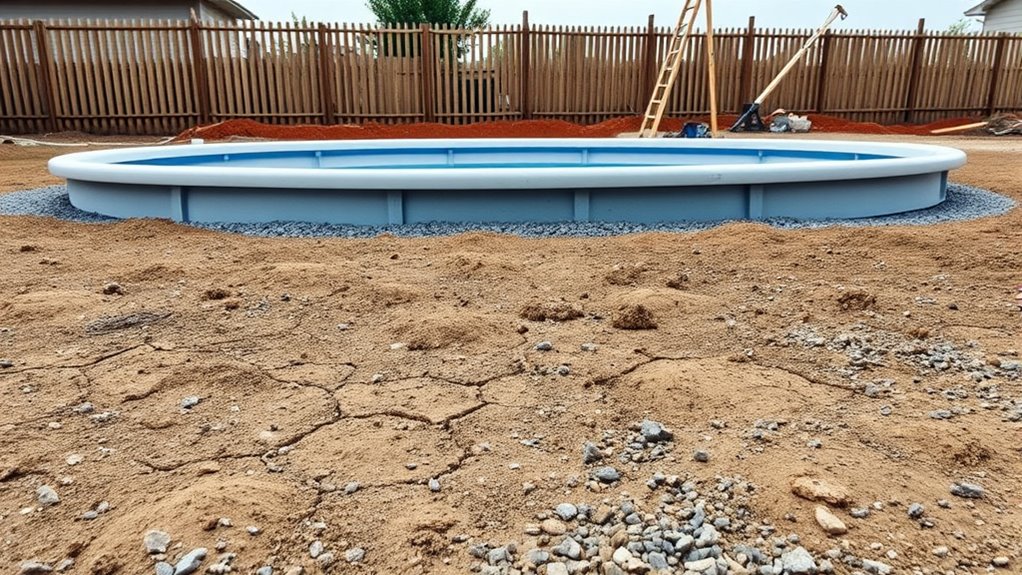
Skipping proper ground preparation can cause your pool to settle unevenly, leading to cracks and structural issues. Poor drainage can result in water pooling around the base, increasing the risk of damage over time. Ignoring these foundational steps puts your entire project at risk from the start. Additionally, neglecting to manage site conditions can compromise the stability and longevity of your pool.
Uneven Surface Risks
Have you considered what can happen if your DIY endless pool isn’t installed on a level surface? An uneven foundation can cause serious issues. First, your pool might shift or sink over time, leading to structural damage. Second, water levels won’t stay consistent, affecting your swim experience. Third, uneven weight distribution can strain the pool’s frame and plumbing, increasing the risk of leaks. Fourth, an unlevel surface can make maintenance difficult and unsafe, increasing the chance of slips or falls. To avoid these risks, verify your ground is perfectly level and solid before installation. Taking the time to properly prepare the foundation saves you money and hassle in the long run, keeping your DIY endless pool safe and functional. Additionally, understanding the importance of a stable foundation is crucial for ensuring long-term durability and safety.
Inadequate Drainage Issues
If you neglect proper foundation and ground preparation, inadequate drainage can quickly become a major problem for your DIY endless pool. Without a solid, level base, water won’t flow away properly, leading to pooling and potential flooding. Poor drainage can cause the pool to shift or sink over time, damaging the structure and increasing maintenance costs. It’s vital to guarantee the ground is well-compacted and graded to direct water away from the pool. Installing a gravel bed or drainage system underneath helps prevent water buildup. Skipping these steps might seem minor initially, but over time, water accumulation can compromise your pool’s foundation, cause leaks, and make upkeep more difficult. Proper ground prep is essential to keep your pool functional and safe long-term, especially considering seasonal checklists that include drainage considerations.
Overlooking Adequate Electrical Setup and Safety Measures

Ensuring your DIY endless pool has an adequate electrical setup is critical for safety and proper operation. Failing to do so can lead to dangerous shocks or equipment failure. To avoid common mistakes, consider these essential steps:
- Hire a licensed electrician to handle wiring and ensure code compliance.
- Use GFCI outlets to protect against ground faults and prevent electrical shocks.
- Verify power requirements match your pool’s pump, heater, and lighting specifications.
- Install proper grounding and bonding to reduce the risk of electrical hazards.
Skipping these steps puts you at risk of serious injury and equipment damage. Take electrical safety seriously and invest in professional help when needed. Proper electrical setup is the backbone of a safe, enjoyable endless pool experience.
Failing to Plan for Proper Water Circulation and Filtration
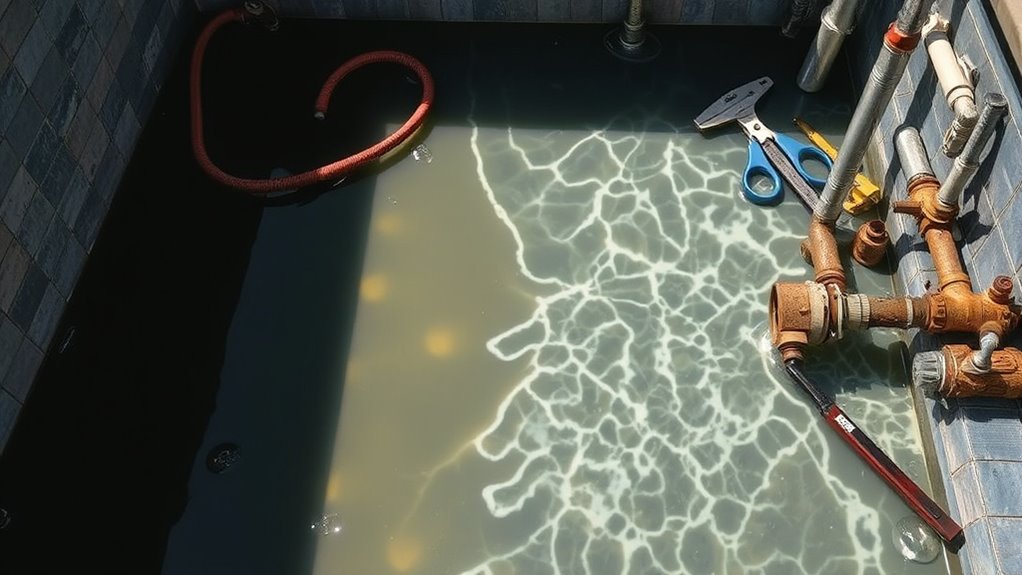
If you don’t plan your water circulation and filtration carefully, your pool won’t stay clean or safe. Choosing the right pump placement, sizing your filter correctly, and optimizing water flow are essential steps. Skipping these details can lead to cloudy water and equipment issues down the line. Regular maintenance and understanding filter replacement requirements are also crucial for ensuring consistent water quality.
Pump Placement Strategy
Proper pump placement is crucial for achieving effective water circulation and filtration in your DIY endless pool. Poor positioning can lead to stagnant spots and poor water quality. To optimize flow, consider these key points:
- Place the pump near the filter and outlet jets to ensure efficient circulation.
- Avoid placing the pump in corners or dead zones where water tends to stagnate.
- Position the pump at a height that prevents air from entering the system, which can cause cavitation.
- Ensure the pump’s inlet isn’t obstructed by debris or pool walls, maintaining consistent water flow.
- Additionally, understanding the water flow dynamics can help you plan pump placement for optimal performance.
Filtration System Size
Selecting the right size for your filtration system is vital to maintaining clean, clear water in your DIY endless pool. An undersized filter won’t effectively remove debris, leading to cloudy water and potential equipment strain. Conversely, an oversized filter can waste energy and cause unnecessary wear. To choose the correct size, consider your pool’s volume, usage frequency, and load. Here’s a quick guide:
| Pool Volume (gallons) | Filter Flow Rate (GPM) | Recommended Filter Size |
|---|---|---|
| Up to 500 gallons | 30-40 GPM | 50 GPM filter |
| 501-1000 gallons | 40-60 GPM | 60 GPM filter |
| Over 1000 gallons | 60+ GPM | 80 GPM or higher filter |
Proper sizing guarantees efficient water circulation and filtration, extending your pool’s lifespan. Proper filtration is essential for maintaining water quality and ensuring your DIY pool remains safe and enjoyable for use.
Water Flow Optimization
Failing to plan for proper water circulation and filtration can lead to stagnant spots, uneven cleaning, and cloudy water in your DIY endless pool. To avoid these issues, focus on enhancing water flow: 1. Position your return jets strategically to ensure even distribution throughout the pool. 2. Use multiple pumps if necessary, to improve circulation and prevent dead zones. 3. Install a reliable filtration system** that matches your pool’s size and flow requirements. 4. Schedule regular maintenance to keep pumps and filters running efficiently. Proper water flow keeps your pool clean, clear, and inviting. Neglecting this step results in water quality problems and increased maintenance efforts. Additionally, considering the water flow system** in detail can significantly improve overall pool performance. Plan carefully to maintain ideal circulation and filtration from the start.
Neglecting Insulation and Climate Considerations
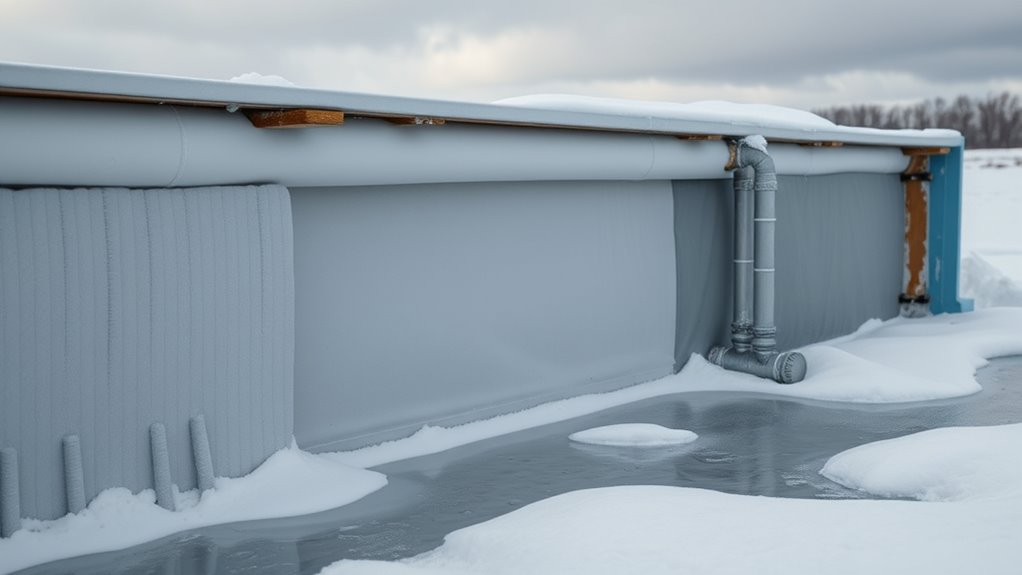
Neglecting insulation and climate considerations can turn your DIY endless pool into a costly mistake. Without proper insulation, heat loss will increase, driving up energy bills and making your pool uncomfortable. Climate plays an essential role: in colder areas, inadequate planning results in rapid heat depletion. To mitigate this, consider insulation types and climate factors carefully. Here’s a quick comparison:
| Climate Zone | Insulation Focus |
|---|---|
| Cold | Heavy insulation, thermal barriers |
| Temperate | Moderate insulation, weatherproofing |
| Hot | Reflective barriers, minimal insulation |
| Humid | Mold-resistant insulation, dehumidify |
Address insulation early, matching it to your climate, to ensure year-round comfort and efficiency. Proper juice extraction techniques can maximize energy efficiency in your setup, just as selecting the right insulation maximizes your pool’s performance.
Skipping Professional Assistance for Critical Installations

While it might be tempting to tackle your DIY endless pool project on your own to save costs, skipping professional assistance for critical installations can lead to serious problems. Without expert guidance, you risk:
- Incorrect electrical wiring, which can cause safety hazards or system failures.
- Faulty plumbing connections, leading to leaks or inefficient water circulation.
- Structural misalignments, risking damage or instability over time.
- Failure to meet local codes, resulting in fines or the need for costly modifications.
Professionals have the experience to handle these complex tasks properly. Skipping their help might save money upfront, but it can cost you much more in repairs, safety issues, or legal problems later. Don’t cut corners on essential installations.
Underestimating Maintenance and Accessibility Needs

Many DIY pool owners underestimate how much ongoing maintenance and accessibility considerations will impact their enjoyment and long-term upkeep. You might think once it’s installed, it’s just a matter of occasional cleaning. However, endless pools require regular filter checks, water chemistry balancing, and equipment inspections to keep the water safe and clear. Failing to plan for easy access to equipment and filters can turn routine maintenance into a hassle. Remember, as the pool ages, components need replacement or repair, which can be costly and time-consuming without proper access. Utilizing air purifier maintenance strategies can help keep your equipment functioning smoothly and extend its lifespan. Neglecting these needs can lead to equipment failures, water quality issues, and increased repair costs. Proper planning for maintenance tasks and accessibility guarantees your pool remains a source of relaxation rather than a maintenance nightmare.
Overlooking Safety Features and Barriers
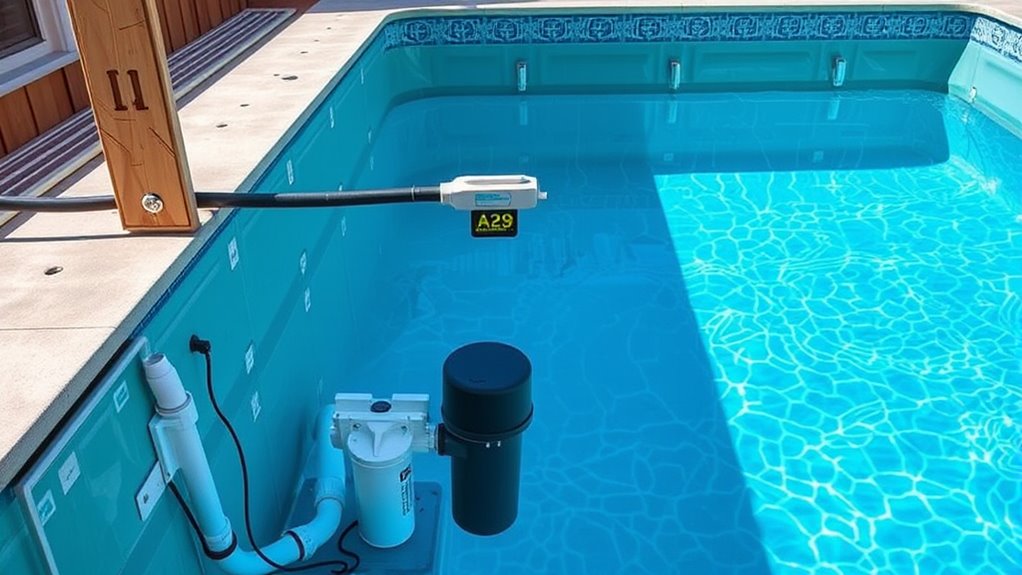
Even if you’re excited about building your DIY endless pool, overlooking safety features and barriers can lead to serious risks. You might assume minimal safety measures are enough, but neglecting them can result in accidents. Here are four critical safety considerations:
- Install secure fencing or barriers around the pool area to prevent unauthorized access.
- Use non-slip surfaces to reduce slipping hazards both inside and outside the pool.
- Ensure proper drainage to avoid water pooling and slipping risks.
- Incorporate alarms or covers that activate if someone enters the pool unexpectedly.
Neglecting these safety features puts everyone at risk. Prioritizing barriers and safety measures protects your loved ones and keeps your DIY project safe and enjoyable.
Improperly Securing Pool Components and Structure

If you don’t secure your pool walls properly, they could shift or collapse over time. Make sure to reinforce all structural connections to keep everything stable and safe. Skipping these steps can lead to costly repairs or dangerous accidents later on.
Secure Pool Walls Properly
Securing pool walls properly is essential to guarantee the stability and safety of your DIY endless pool. Failing to do so can lead to structural failure or leaks. To get it right, focus on these key steps:
- Tighten all bolts and screws securely, avoiding over-tightening that could crack the material.
- Use appropriate sealants at joints and seams to prevent water leaks.
- Ensure panels are aligned perfectly before fastening to avoid warping.
- Double-check that all supports and braces are firmly in place before filling the pool.
Reinforce Structural Connections
Reinforcing structural connections is essential to prevent movement or failure of your DIY endless pool. You need to verify all joints, bolts, and supports are securely fastened and properly aligned. Use high-quality, corrosion-resistant materials to withstand water exposure and weather conditions. Double-check that the pool frame is level and stable before filling it with water. Adding extra braces or supports at critical points can help distribute weight evenly and reduce stress on individual components. Avoid shortcuts like skipping tightening screws or neglecting to secure connections tightly. A solid foundation and reinforced connections guarantee safety, durability, and prevent costly repairs down the line. Take the time to reinforce every connection thoroughly; it’s the key to a long-lasting, safe DIY endless pool.
Not Testing the System Thoroughly Before Use

Skipping a thorough test of your DIY endless pool before regular use can lead to unexpected problems and safety hazards. You need to verify everything works perfectly to avoid costly repairs or accidents. Here’s what to check:
- Water circulation and filtration: Ensure pumps and filters operate smoothly without leaks or unusual noises.
- Water temperature control: Confirm temperature settings stay consistent and respond correctly.
- Electrical systems: Test all wiring, switches, and alarms to prevent electrical hazards.
- Structural stability: Check for leaks, cracks, or weak spots after filling the pool.
Testing thoroughly helps identify issues early, saving you time and money. It also guarantees your pool is safe and ready for regular use, giving you peace of mind every time you swim.
Ignoring Local Regulations and Permitting Requirements

Before you start using your DIY endless pool, it’s important to make sure you’re complying with local regulations and permits. Ignoring these requirements can lead to fines, delays, or even having to dismantle your pool. Check with your city or county building department to understand zoning laws, safety codes, and permit procedures. Some areas may require inspections or specific setbacks from property lines. Failing to obtain the necessary permits might also void your homeowner’s insurance in case of accidents. Take the time upfront to research and secure all necessary approvals. Doing so guarantees your project is legal, safe, and protected from costly setbacks down the line. Staying compliant helps you enjoy your pool worry-free, knowing you followed the proper legal channels.
Frequently Asked Questions
What Are the Common Signs of Installation Issues in a DIY Endless Pool?
You’ll notice installation issues in your DIY endless pool if you see uneven water levels, persistent leaks, or inconsistent filtration. Cracks in the shell or surrounding structure indicate improper setup, while difficulty maintaining temperature or abnormal noise suggests equipment problems. If the pool doesn’t feel stable or shifts when you step in, it’s a sign that the foundation wasn’t installed correctly. Address these signs promptly to avoid further damage.
How Can I Troubleshoot Water Circulation Problems Effectively?
Troubleshooting water circulation problems is like untangling a knot; you need patience and focus. Start by checking the pump and filter for clogs or debris, and guarantee all valves are open and functioning correctly. Inspect the circulation pump for leaks or unusual noises. If issues persist, verify that the water level is appropriate, and reset the system if necessary. Regular maintenance keeps your pool running smoothly and trouble-free.
What Safety Features Should I Prioritize During Installation?
You should prioritize safety features like anti-slip surfaces around the pool, proper electrical grounding, and secure fencing or barriers to prevent accidents. Make certain all electrical components are installed by a qualified professional to avoid hazards. Installing a safety cover and clear signage also helps prevent unauthorized access. Regularly inspect these features to guarantee they remain effective, and always follow local safety regulations for pool installations.
How Often Should I Inspect and Maintain My Pool System?
You should inspect and maintain your pool system at least once a month. Regularly check the filters, pumps, and jets for signs of wear or debris. Keep an eye on water chemistry and clean the filter as needed to prevent buildup. Also, examine the electrical components and safety features to ensure they’re functioning correctly. Consistent maintenance helps prolong your pool’s lifespan and keeps the water safe and clean for your enjoyment.
Are There Hidden Costs Associated With DIY Endless Pool Installation?
Sure, there are hidden costs lurking around your DIY Endless Pool project. While you might think you’re saving money, unexpected expenses like special permits, tools, or professional help can sneak up on you. Plus, if you mess up installation, fixing it could cost more than hiring a pro initially. So, enjoy the illusion of savings—just remember, some costs are invisible until they hit your wallet.
Conclusion
Skip these mistakes, and you’ll turn your DIY endless pool into a disaster zone—leaking like a broken dam, electrical sparks flying everywhere, and a safety nightmare you’ll regret forever. But follow these tips, and you’ll have a perfect oasis right in your backyard, safer than Fort Knox, and so luxurious, you’ll feel like a millionaire every time you plunge in. Don’t mess around—get it right the first time and enjoy endless swimming without the chaos!

